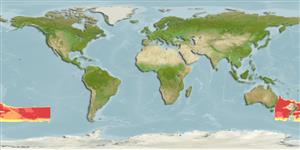>
Lophiiformes (Anglerfishes) >
Gigantactinidae (Whipnose anglers)
Etymology: Gigantactis: Greek, 'gigas' or 'gigantos' = gigantic + Greek, 'aktis' = ray (referring to the unusually long first dorsal-fin spine that functions as a lure in this genus) (Ref. 86949).
Eponymy: Dr John Richard Paxton (d: 1938) is an American-born Australian ichthyologist. [...] (Ref. 128868), visit book page.
Environment: milieu / climate zone / depth range / distribution range
Écologie
marin bathypélagique; profondeur 540 - 1500 m (Ref. 86949). Deep-water
Southwest Pacific.
Taille / Poids / Âge
Maturity: Lm ? range ? - ? cm
Max length : 29.5 cm SL mâle / non sexé; (Ref. 58502)
Description synthétique
Clés d'identification | Morphologie | Morphométrie
Rayons mous dorsaux (Total) : 6 - 7; Rayons mous anaux: 5 - 6. Metamorphosed females distinguished by the following characteristics: have filaments on the dorsal surface of head just behind the base of the illicium; length of illicium 168-198% SL; presence of short filaments on base of illicium; escal bulb gradually tapering into a conical, spinulose darkly pigmented distal prolongation, length 12-28% SL; escal bulb and distal prolongation bearing low unpigmented papillae; short filaments present on distal prolongation, absent on base of escal bulb; absence of posterior pair of close set illicial appendage; long dentary teeth (longest tooth 3.4-7.1% SL), three or four longitudinal series in posterior part of jaw; short rays of caudal fin (27.5-35% SL) (Ref. 86949).
Bathy- and mesopelagic species (Ref. 75154).
Life cycle and mating behavior
Maturité | Reproduction | Frai | Œufs | Fécondité | Larves
Paxton, J.R., D.F. Hoese, G.R. Allen and J.E. Hanley, 1989. Pisces. Petromyzontidae to Carangidae. Zoological Catalogue of Australia, Vol. 7. Australian Government Publishing Service, Canberra, 665 p. (Ref. 7300)
Statut dans la liste rouge de l'IUCN (Ref. 130435: Version 2024-2)
Menace pour l'homme
Harmless
Utilisations par l'homme
Pêcheries: sans intérêt
Outils
Articles particuliers
Télécharger en XML
Sources Internet
Estimates based on models
Preferred temperature (Ref.
123201): 6.5 - 8.3, mean 7.8 °C (based on 9 cells).
Phylogenetic diversity index (Ref.
82804): PD
50 = 0.5000 [Uniqueness, from 0.5 = low to 2.0 = high].
Bayesian length-weight: a=0.01995 (0.00906 - 0.04395), b=3.01 (2.83 - 3.19), in cm total length, based on all LWR estimates for this body shape (Ref.
93245).
Niveau trophique (Ref.
69278): 4.2 ±0.7 se; based on size and trophs of closest relatives
Fishing Vulnerability (Ref.
59153): Low to moderate vulnerability (26 of 100).
